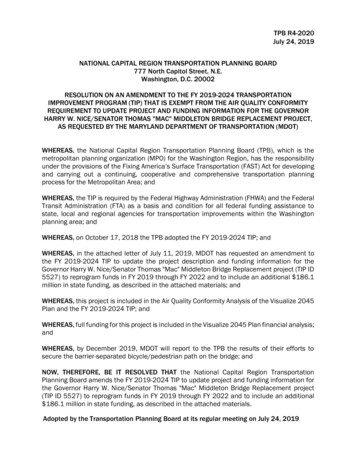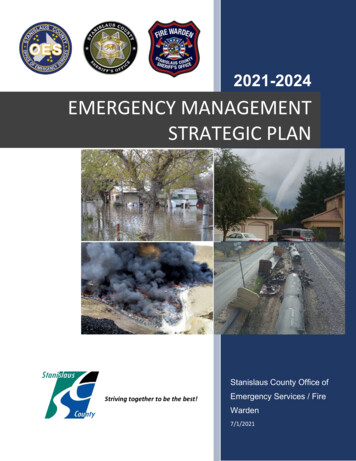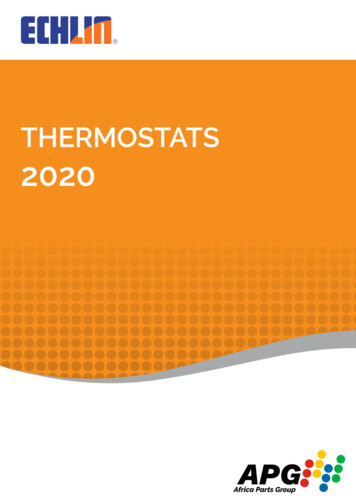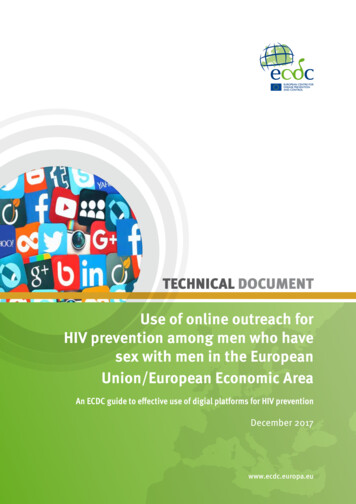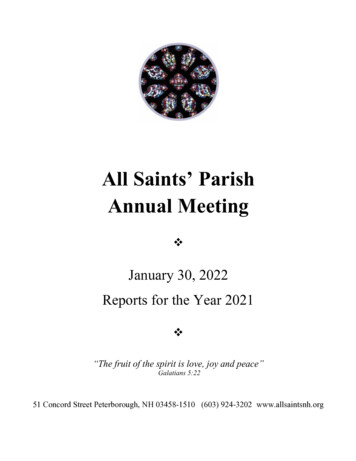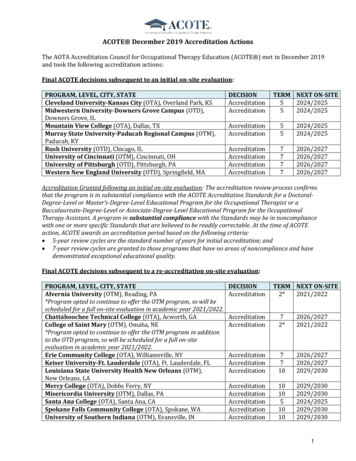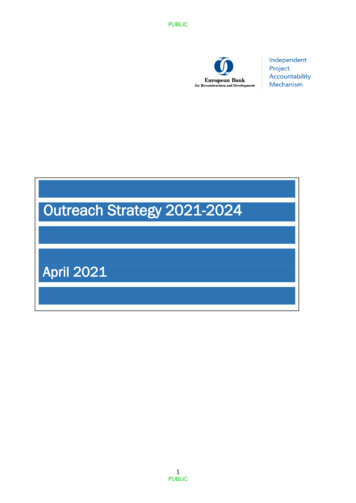
Transcription
PUBLICOutreach Strategy 2021-2024April 20211PUBLIC
PUBLICThe Independent Project Accountability Mechanism (IPAM) is the accountability mechanism of theEBRD. It receives and reviews concerns raised by Project-affected people and civil societyorganisations about Bank-financed Projects, which are believed to have caused harm. IPAM mayaddress Requests through two functions: Compliance Review, which seeks to determine whetheror not the EBRD has complied with its Environmental and Social Policy and/or the Project-specificprovisions of the Public Information Policy; and Problem-Solving, which has the objective ofrestoring dialogue between the Requesters and the Client to resolve the issue(s) underlying aRequest without attributing blame or fault. Affected Parties can request one or both of thesefunctions.For more information about IPAM, contact us or visit ct informationThe Independent Project AccountabilityMechanism (IPAM)European Bank for Reconstruction andDevelopmentOne Exchange SquareLondon EC2A 2JNHow to submit a complaint to the IPAMConcerns about the environmental and socialperformance of an EBRD Project can besubmitted by email, telephone or in writing, orvia the online form at: hone: 44 (0)20 7338 6000Email: ipam@ebrd.com2PUBLIC
PUBLICTable of ContentsList of Abbreviations. 4I.Introduction . 5II.Scope of the Strategy . 5III.Guiding Principles and Effectiveness Indicators . 5IV.Project Accountability Policy Provisions . 6a.Definitions . 6b.Scope - Functions and Governance . 7c.Outreach and Training . 7d.Reporting. 8V.External Outreach . 9a.What is External Outreach . 9b.Target Audiences . 9a.External Outreach Objectives. 9d.Outreach Proposed Actionable Areas . 10VI.Internal Outreach and Training .13a.What is Internal Outreach and Training . 13b.Target Audiences .13d.Internal Outreach and Training Proposed Actionable Areas . 14VII.Resources .15a.Human Resources . 16VIII.Implementation and Evaluation.17Annexes . 19Annex 1 - Quarterly Meeting with Civil Society Organisations .19Annex 2 – Role descriptions . 203PUBLIC
PUBLICList of IAMNetIFIIPAMPAPPCMROLong FormAccess to Information PolicyChief Accountability OfficerCivil Society OrganizationCivil Society Engagement UnitEuropean Bank for Reconstruction and DevelopmentExternal Consultative GroupHead QuartersIndependent Accountability MechanismIndependent Accountability Mechanism NetworkInternational Financial InstitutionEBRD’s Independent Project Accountability MechanismProject Accountability PolicyProject Complaint MechanismEBRD’s Resident Office4PUBLIC
PUBLICI.IntroductionThe Project Accountability Policy (PAP) approved by the EBRD Board of Directors in 2019, providedfor the establishment of the Independent Project Accountability Mechanism (IPAM). In July 2020,the PAP came into effect with the appointment of the first Chief Accountability Officer (IPAM Head).IPAM’s purpose, as per the PAP, is to facilitate the resolution of social, environmental and publicdisclosure issues among project stakeholders; to determine whether the Bank has complied withits Environmental and Social Policy and the Project-specific provisions of its Access to InformationPolicy; and where applicable, to address any existing non-compliance with these policies, whilepreventing future non-compliance by the Bank. It also has a mandate to do outreach andinstitutional learnings.The preparation of an outreach strategy is one of the foundational actions undertaken by IPAM inits first year of operation. The strategy will serve as guidance to the IPAM team for the design andimplementation of Outreach annual activity programmes, and will establish the set of indicators toassess performance.The Outreach Strategy follows the provisions set in the Project Accountability Policy1 and adoptedthe UN Guiding Principles on Business and Human Rights proposed criteria to assess itseffectiveness. Additionally, as part of the drafting process, a consultant was hired to provide anassessment of outreach efforts to date (both by PCM and IPAM), provide expert insights on how topromote accessibility and transparency through outreach and map best practices of independentaccountability mechanisms (IAM). This final document was consulted with civil societyorganisations, relevant Bank stakeholders and other IAMs to invite comments and suggestionsprior to finalising this Strategy.II.Scope of the StrategyIPAM, as responsible for the implementation of the PAP established in its 2021 Work Programme,the goal of producing an Outreach Strategy (“the Strategy”) to guide its outreach efforts to internaland external stakeholders for the period 2021-2024. The Strategy will serve as a guide for thedesign and implementation of an annual outreach programme for the stated period and may beadjusted after the first year based on results.III.Guiding Principles and Effectiveness IndicatorsThe PAP establishes the following guiding principles for IPAM operation:Box 1. IPAM Guiding tabilityPredictabilityAccessibilitySource. Project Accountability PolicyRelevant sections of the Policy have been included in this document as framework to the proposed actions. Someminor editing on the original text has been introduced for ease of reading but without change in the substance of theprovisions.15PUBLIC
PUBLICIPAM’s effectiveness in fulfilling its mandate is determined by how its actions and outcomes areable to respond to the guiding principles set in its Policy. In this sense, any measure of success,i.e. of an effective mechanism, should consider the fulfilment of these guiding principles.In order to ensure that IPAM achieves the objectives set in relation to Outreach and Training, itneeds to identify a set of indicators and establish measurable targets for each one. The UN GuidingPrinciples for Business and Human Rights (See Box 2) have established seven effectivenesscriteria, which combined with the PAP guiding principles, provide IPAM with a solid basis tomeasure progress and as such, the objectives and goals in this outreach strategy have beendefined in line with them. (See Evaluation section for further detail)Box 2. UN Guiding Principles Effectiveness Criteria for Non-Judicial Grievance MechanismsThe UN Guiding Principles on Business and Human Rights rest on three pillars: I. Protect; II. Respect and; III.Remedy. Independent Accountability Mechanisms are one of the non-judicial grievance mechanisms avenuesconsidered by the third pillar of the UNGP to provide access to remedy for victims of business and relatedabuses. The UNGP’s establish a set of effectiveness criteria for non-judicial grievance mechanismsLegitimate: enabling trust from the stakeholder groups for whose use they are intended, and beingaccountable for the fair conduct of grievance processes;Accessible: being known to all stakeholder groups for whose use they are intended, and providing adequateassistance for those who may face particular barriers to access;Predictable: providing a clear and known procedure with an indicative time frame for each stage, and clarity onthe types of process and outcome available and means of monitoring implementation;Equitable: seeking to ensure that aggrieved parties have reasonable access to sources of information, adviceand expertise necessary to engage in a grievance process on fair, informed and respectful terms;Transparent: keeping parties to a grievance informed about its progress, and providing sufficient informationabout the mechanism’s performance to build confidence in its effectiveness and meet any public interest atstake;Rights-compatible: ensuring that outcomes and remedies accord with internationally recognized human rights;A source of continuous learning: drawing on relevant measures to identify lessons for improving themechanism and preventing future grievances and harms.IV.Project Accountability Policy ProvisionsThe IPAM mandate and process is outlined in the Project Accountability Policy and any actionsundertaken by the IPAM team are subject to it. Thus here below an abstract of the PAP provisionsrelevant to outreach and institutional learnings.a. DefinitionsIndependent Project Accountability Mechanism (IPAM) - is the independent project accountabilitymechanism established under the Project Accountability Policy.6PUBLIC
PUBLICIPAM Head - the Chief Accountability Officer responsible for the running of IPAM, theimplementation of the Policy and for making decisions that are the responsibility of IPAM underthis Policy.b. Scope - Functions and GovernanceIPAM has two complementary, non-judicial and non-adversarial functions for handling Requests:Problem Solving and Compliance. IPAM also has a mandate to: Identify institutional learnings that distinguish common challenges, provide constructiverecommendations and promote a culture of continuous learning at EBRD. Conduct outreach among internal and external stakeholders, in order to ensure that IPAM’spurpose, functions and activities are known and understood.c. Outreach and TrainingIPAM’s mandate to do outreach is further clarified in section 3.2 of the PAP, with a number ofprovisions (see below) related to who IPAM stakeholders are, promoting access and focusing onthe effectiveness of actions:IPAM’s ability to fulfil this mandate is dependent on its capacity to effectively engage with itsstakeholders. Further, it establishes that IPAM is to conduct outreach among both internal andexternal stakeholders, in order to promote greater knowledge and understanding of the Policy andIPAM’s purpose, functions and activities.In addition, it establishes the obligation to develop an outreach programme to that effect; and toinclude in it cooperation with other institutions’ accountability mechanisms, as appropriate.In relation to reducing barriers to access, the PAP signals for IPAM to be responsive to constraintsimpeding stakeholders’ access to IPAM, engagement in Cases, or participation in outreachinitiatives. IPAM is to engage with Vulnerable People or groups in the EBRD territories or countriesof operation and to advance stakeholder access efficiently and cost-effectively.Accessibility: working to be known to individuals andgroups that could use IPAM; ease barriers to access;operate in a culturally appropriate and genderresponsive manner; and promote safe access toIPAM through confidential Case handling, Retaliationrisk assessment and risk mitigation measures.PAP Guiding PrinciplesAs shown in the box above, the PAP establishes Accessibility as one of its guiding principles andprovides language on how to operationalise the principle. Further to this, the PAP includesprovisions on how to make the Mechanism more accessible:Accessibility through Engagement Materials. IPAM will develop, publish and distribute a range ofengagement materials to enhance internal and external stakeholders’ understanding of IPAM’s7PUBLIC
PUBLICmandate, policies, functions and activities. If feasible, IPAM will consult externally on thedevelopment of such materials to promote their accessibility to Project affected People.IPAM will also maintain an interactive website through which it will disseminate information andmaterials related to its work.Accessibility through language. IPAM aims for effective communication and disclosure of its reportsand activities among internal and external stakeholders. Although English is the working languageof IPAM, IPAM is to seek to make reports and communication materials available in relevant locallanguages as needed to create and maintain access to IPAM. As a start, the Policy is to be availablein English, Russian, and Arabic and translated into other official languages of EBRD countries ofoperation or territories on a progressive basis.Requests may be submitted in any official language of an EBRD country of operation or territory,or in any of the official languages of EBRD (i.e. English, Russian, French or German); and IPAMcommunications will be both in the language of the Request and in English.For outreach activities, if English is not spoken, IPAM is to offer communications in the relevantlocal language, through translation and interpretation services.Safe access. IPAM is not to tolerate Retaliation against Requesters or any other individualsinvolved in the IPAM process or outreach activity and rejects any form of threat, intimidation,harassment, violence or discrimination based on the fact that they have exercised their right toraise concerns. To this end, confidentiality is to be granted and IPAM commits to taking steps toassess the risk and implement mitigation measures in consultation with the Requesters.Training.IPAM shall provide training and familiarisation services to Bank staff and externalstakeholders with regard to the implementation of this Policy.In its access promotion, the PAP envisions the support of Bank staff in HQ and Resident Offices,who are to be encouraged to integrate IPAM information into other Bank activities and publications.As well, as support IPAM’s efforts to publicise its mandate and functions.In addition, a measure of the effectiveness of the Mechanism is its predictability and equitability,two of the IPAM guiding principles.d. ReportingPredictability: offering clear, consistent processes and proceduresEquitability: working to ensure that all Parties have reasonable accessto the information necessary to engage in IPAM processes on fair andinformed terms, while respecting appropriate confidentialityrequirements.Finally, the Policy establishes reporting obligations to IPAM:8PUBLIC
PUBLICThe IPAM Head is to make quarterly presentations to the Audit Committee (EBRD Board) andprovide briefings to the Board upon request or as needed.IPAM will prepare an Annual Report that shall describe registered Requests, Case outcomes,completed outreach initiatives and institutional learnings from the preceding fiscal year. AnnualReports will be submitted to the Board and the President for information, and disseminated to thepublic as soon as possible thereafter through the IPAM website.V.External Outreacha. What is External OutreachExternal outreach is defined by IPAM as all actions and behaviours of IPAM staff in its dailyoperation with the objective of promoting and increasing accessibility to the Mechanism within thescope provided by the PAP. Thus defined, outreach goes beyond producing dissemination materialsand organizing awareness-raising activities. It envisions accessibility as the guiding principle toassist in decisions to be made and resources to be allocated for our engagement with stakeholdersbefore, during and after Requests are received.b. Target AudiencesIPAM’s ability to fulfil its mandate is dependent on its ability to effectively engage with a range ofstakeholders. For external outreach purposes, IPAM identifies as target audiences:Primary Targets: project-affected people in the EBRD countries of operation and civil societyorganisations that advise and support the former in accessing the Mechanism. The latter can bedivided into international/regional CSOs and national/local organisations.Secondary Targets: Additionally, Bank staff in Banking and ROs and Clients are consideredsecondary stakeholders, (i.e. those that although are not the main target of the Strategy, due totheir interests or role have an obligation set in the Policy to raise awareness of IPAM).a. External Outreach Objectives Raise awareness about the Mechanism amongst affected (or potentially affected)communities, civil society organisations residing or active in the EBRD countries of operationand other relevant stakeholders (international/regional/local).Provide clear and relevant information about IPAM’s purpose, functions and activities in aculturally appropriate, user-friendly and understandable way.Advise stakeholders about IPAM’s Case methodology, activities, and findings.Identify relevant vehicles and partners to reach out to stakeholdersCollaborate with IAMNetwork members and other relevant institutions to promote awarenessand access to accountability in general.Establish measures (commensurate to the IPAM mandate and its capacity) to allow for safeaccess to the Mechanism.Build credibility and promote an image of impartiality9PUBLIC
PUBLICd. Outreach Proposed Actionable Areas1.ContinuousPromoting access is the responsibility of the IPAM team as a whole and within its daily operation;the following actions will have to be implemented in a systematic fashion through the year:a.WebsiteDuring 2020, basic information on IPAM was updated in the dedicated sections of the EBRDwebsite. Early in 2021, the new case registry was launched which included new functionalities anddedicated case pages for greater transparency and predictability. As part of the refurbishment, anelectronic complaint format was introduced with information prompts to assist the Requester inEnglish, Russian and Arabic.However, the website is IPAM’s main outreach tool and the team should continue to ensure that itprovides clear, useful, accessible information to potential requester as well as to otherstakeholders. The website should become a one-stop shop for the provision of information aboutIPAM, how to submit a complaint and clarification on its services and their scope and potentialoutcomes.In collaboration with the EBRD’s Information Technology and communications department,enhancements to the IPAM webpage including, but not limited to integrating platforms sosubscribers/users can sign up for automatic emails whenever a new Request is registered;improved look and feel features; and linkages to social media platformsThe webpage will be periodically assessed for accessibility and transparency through user surveys.b.Outreach materialsTaking the PAP as the normative basis, IPAM will produce outreach materials under the principlesof clarity, focus and cultural sensitivity to promote better understanding of the mandate, processand potential outcomes.Printed materials will be available in English, Russian and Arabic, and progressively translated toall official languages of the countries of operation.New formats for disseminating information that are a better fit to communities will be periodicallyreviewed, in collaboration with external stakeholders, Requesters and EBRD’s CommunicationsDepartment as relevant.c.Social Media2The Analyst, under the guidance of the CAO and the Effectiveness, Engagement and Learning Advisor, will beresponsible for management of IPAM’s social media outlets and analyzing its contribution to the Outreach Strategyobjectives.210PUBLIC
PUBLICThe reach that social media has makes it an indispensable tool to promote access to theMechanism. As stated in EBRD’s Social Media Guidance “as a highly successful internationalfinancial institution, the EBRD has much to gain from sharing its successes and communicatingwhat we want to say via social media. We can, for example, use them to find new audiences forwhat we want to say and deepen our engagement with them and people already in our networks.”The PAP and the EBRD’s Social Media Guidance will regulate social media engagement by IPAM.IPAM may seek guidance and support from the Communications department as needed. By thesecond semester of 2021, IPAM will have initiated periodic outreach in Facebook, Linkedin andTwitter. Social media postings will seek to increase visibility of our casework and progress madein each case and to assist our mapping of stakeholders.Social media will be used to promote navigation to our webpage and Case Registry. For thatpurpose, case updates will be made through our social media platforms with links to the CaseRegistry summary for further information. A quarterly IPAM brief will be pushed through socialmedia, including past and future activities.d.One-on-one Communication with active and potential RequestersPromoting access to the Mechanism should not rely only on traditional outreach activities; it isintrinsically linked with how we engage with our stakeholders during everyday operations.Communications will be drafted avoiding jargon and tunnel vision, striving for cultural sensitivityand personal touch. Understanding our mandate and our process is not to be a duty of ourstakeholders but rather our key challenge to ensure that we are communicating effectively.Whenever possible, written communications should be accompanied by face-to-facecommunication.e.Development and update of stakeholder map and routine contactThe EBRD operates in 39 countries, but currently IPAM only engages systematically with a coregroup of civil society organisations that are highly knowledgeable about the IFI landscape,environmental and social safeguards and accountability mechanisms. Some of them operate atthe international or regional level, and a few of them are of a local nature.The challenge for IPAM is to work systematically in developing strategic contacts in each one of the39 countries of operation while maintaining its engagement with its core stakeholders. For thatpurpose, IPAM will establish actions to identify and reach out to new local organisations. Theengagement will be focused on raising awareness of accountability at EBRD, introducing IPAM andits process. The overall aim is to ensure that project affected communities in countries of operationknow about IPAM, understand how to access it if needed. IPAM will engage with EBRD’s CivilSociety Engagement Unit in the development and update of stakeholder mapping exercise androutine contact.f.Engagement with IAMNetwork membersThe IAM Network is comprised of 22 independent accountability mechanisms that meet annuallyto share good practices, identify trends and exchange knowledge. IAMNet members also seek to11PUBLIC
PUBLICcollaborate in cases where co-funding is present and to promote access to the accountabilityfunctions in a coordinated fashion. IPAM is to maintain an active participation within the networkand collaborative outreach actions compatible with its own objectives.2.Recurrenta.Quarterly meeting with Civil Society OrganisationsAccessibility, transparency and predictability are at the core of every IPAM action. Therefore, toensure that the mechanism is effectively implementing these guiding principles, but also learningabout the challenges of communities in accessing IPAM and understanding the process, quarterlymeetings with its core CSO stakeholders is to be organized periodically. Further details on theinitiative, its objectives and format can be found in Annex 1.b.EBRD Annual MeetingIn coordination with the Civil Society Engagement Unit, IPAM will participate in relevant activitieswithin the agenda of the EBRD Annual Meetings, as observer and/or organiser. In addition tothat, whenever relevant, it will engage with local organizations to deliver a Promotion AccessWorkshop to local civil society organisations with common interests.Year2021202220232024c.HostLondon, UK (28 Jun – 2 Jul)Marrakesh, MoroccoSamarkand, UzbekistanYerevan, ArmeniaRegional/Country Specific Workshops to Promote AccessAnnually, IPAM will undertake at least two regional/country specific workshops to promote access.The workshops will preferably be organized in collaboration with other sister IAMs, and will seek toidentify a local CSO partner to lead in the coordination and identification of relevant participants.The countries will be identified based on EBRD country portfolio and past events.d.IAMNetwork Outreach ActivitiesIPAM participates in the Outreach IAMNet committee that identifies joint outreach initiatives andwill include those that are relevant to its mandate and objectives in its annual program. This is notlimited to events, and include other showcasing alternatives such as joint publications, productionof outreach materials, development of good practice notes, participation in relevant fora as a groupand engaging with relevant institutions to promote accountability.e.Participation in relevant foraIPAM routinely participates in relevant fora as guest speaker establishing the leadership of EBRDin accountability as well as enlarging its network of relevant contacts. A non-exhaustive list of thisis provided below.12PUBLIC
PUBLICImpact Assessment International Association Annual ConferenceOECD Global Forum on EnvironmentUN Business and Human Rights ForumUN Indigenous People ForumOther IFI’s Annual meetingsf.Annual ReportAs part of its reporting obligations, IPAM produces its Annual Report that describes registeredrequests, case outcomes, completed outreach initiatives and institutional learnings from thepreceding fiscal year. This product is also an excellent outreach material for showcasing the workof IPAM and providing guidance on how to access the mechanism, and as such will be used.3.One-offDuring the annual planning process, IPAM will identify outreach opportunities that may be of a oneoff nature such as relevant international conferences or the celebration of a specific milestone forthe EBRD or in the countries of operation.Also considered as one-off are the production of certain outreach materials which require highinvestments in preparation and production, which include but are not limited to redesign of theIPAM website, design and production of access promotion training workshops, case studies, videosor special publications.VI.Internal Outreach and Traininga. What is Internal Outreach and TrainingInternal outreach is defined by IPAM as all actions and behaviours of IPAM staff in regards to itsengagement with Bank staff in headquarters and Resident Offices aimed at raising awareness ofthe PAP, and promoting predictability and efficiency. For these purposes, the PAP establishes thatIPAM shall provide training and familiarisation services to Bank staff and external stakeholders onits implementation.In addition, given that the PAP envisions the support of Bank staff in HQ and Resident Offices inpromoting access, Bank staff require robust understanding and knowledge of IPAM’s mandate andCase processing.Finally, IPAM needs to engage Management to jointly identify where and how to integrate IPAMinformation into other Bank activities, documents and publications.b. Target AudiencesFor internal outreach and training, although awareness-raising about IPAM and accountabilityshould be bank wide, there are specific groups that should be considered as primary targets. Thoseinclude Board members, Bank staff in HQ and ROs responsible for origination, due diligence,implementation and monitoring; those engaging with civil society periodically; those responsible13PUBLIC
PUBLICfor reporting; and finally other offices related to the good governance of the Bank. In the tablebelow, a non-exhaustive list is provided: Access to InformationBankingCivil Society Engagement UnitCo-financing and external relationsDonor Co-financingEnvironment and Sustainability DepartmentFinancial InstitutionsInfrastructureLegal TransitionOffice of the General CounselOther Independent Offices: Evaluation Department, Internal Audit, Office of the Chief Compliance Officer.Procurement OfficeRisk Managementc. Objectives Promote greater knowledge and understanding of the Project Accountability Policy andIPAM’s purpose, functions and activities.Provide guidance on routine engagement with IPAM and/or IPAM-related issues.Collaborate in the identification of outlets where to insert IPAM information.Develop common understandings of each Party’s function to facilitate a respectfulrelationship.d. Internal Outreach and Training Proposed Actionable AreasIn line with the mandate of IPAM annual programmes will include systematically a combination ofcontinuous, recurrent and one-off actions. For the development of this section, key Bankstakeholders were consulted.1.Mandatory trainingAs the PAP includes provisions for the
The Independent Project Accountability Mechanism (IPAM) is the accountability mechanism of the EBRD. It receives and reviews concerns raised by Project-affected people and civil society organisations about Bank-financed Projects, which are believed to have caused harm. IPAM may address Requests through two functions: Compliance Review, which .

